
How to Write a Web Development Contract: A Step-by-Step Guide
A web development contract is the cornerstone of any successful digital project. It serves as the legal foundation that protects both clients and developers throughout the development lifecycle. Whether you’re partnering with top-rated web development firms or working with independent contractors, having a comprehensive contract for web development agreement ensures clarity, accountability, and mutual protection.
According to research, the web development industry is experiencing steady growth, with a value of $80.6 billion by 2025. It is expected to reach $125.4 billion by 2030, with a CAGR of 9.3%. As the market booms in the near future, businesses having poorly drafted contracts will create payment disputes. Hence, in this blog, you’ll learn how to write a well-structured agreement and know what to include in it.
- 1) What Is a Web Development Contract and Why Do You Need One?
- 2) How to Write a Web Development Contract
- 3) What Business Code Should Be Used for Contract Web Developers?
- 4) Understanding Grey Areas in Web Development Contract
- 5) Where to Find Contract Web Developer Services
- 6) Key Clauses to Negotiate in Your Web Development Contract
- 7) Best Practices for Contract Management
- 8) Conclusion
What Is a Web Development Contract and Why Do You Need One?
The Foundation of Successful Digital Projects
Every successful website begins with a legally binding document that outlines expectations, responsibilities, and deliverables. Unlike informal handshake agreements, a formal web development contract provides enforceable protection while establishing a clear roadmap for project completion. This documentation defines the exact scope of work, prevents misunderstandings about features, establishes payment terms, and creates a dispute resolution framework.
Moreover, these agreements protect intellectual property rights by stating who owns the final product, source code, and design assets. For businesses investing significant resources into their digital presence, this clarity proves invaluable. The contract for web development agreement also establishes quality standards, testing procedures, and acceptance criteria that prevent endless revision cycles.
The Cost of Working Without Proper Documentation
Operating without a comprehensive agreement exposes both parties to substantial risks. Research indicates that 37% of projects fail due to insufficient scope definition, with many failures stemming from absent contractual boundaries. When expectations remain unwritten, scope creep becomes inevitable, small requests accumulate into massive budget overruns and timeline extensions.
Payment disputes represent another common consequence. Without clearly defined milestones and deliverable acceptance criteria in a web development contract, clients may withhold payment while developers struggle to demonstrate completed work.
Additionally, intellectual property battles frequently emerge when ownership terms remain ambiguous. Verbal agreements rarely hold up in court, leaving parties vulnerable when disputes escalate.
How to Write a Web Development Contract
Defining Project Scope and Deliverables
Crafting a comprehensive scope definition stands as the most crucial element of any contract for web development agreement. This section must detail every aspect of the website being developed, from the number of pages and specific features to design requirements and technical specifications.
Vague descriptions invite disaster. So instead, contracts should clearly list exact deliverables, including specific numbers, features, and functionalities.
Beyond high-level features, detailed scope documentation should specify design parameters. It should include revision rounds (typically 2-3), wireframe deliverables, brand guideline adherence, and responsive design breakpoints. Technical specifications must address platform choices, hosting requirements, browser compatibility standards, and third-party integrations.
Additionally, the web development contract should clearly delineate what’s NOT included:
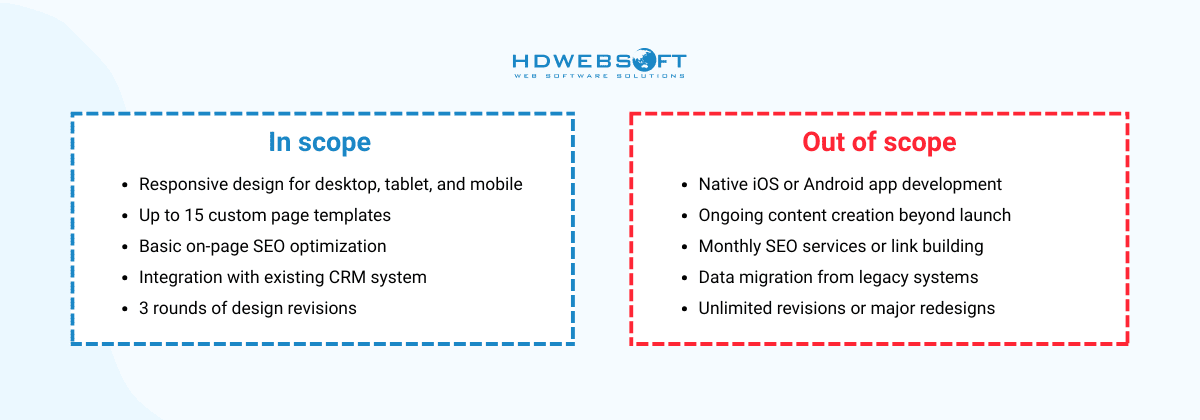
Timeline, Milestones, and Payment Structure
Establishing realistic timelines with clearly defined milestones protects both parties from indefinite project duration. Rather than a single deadline, professional web development agreement contracts break projects into phases with specific deliverables and completion dates. Each milestone should trigger a payment installment, distributing financial risk appropriately:
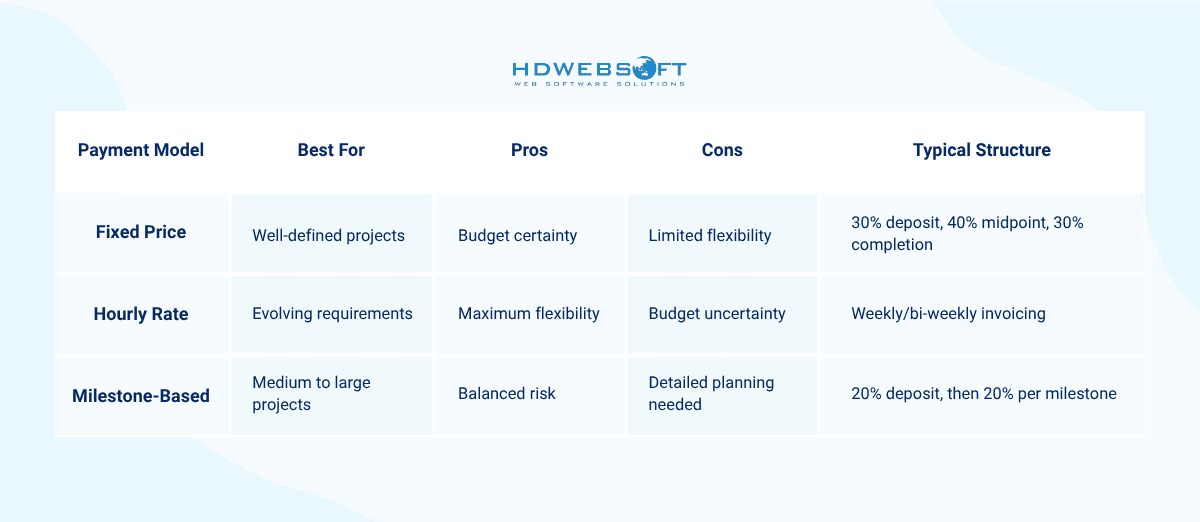
The contract for web development agreement should also address late payment consequences (typically 1.5-2% monthly interest) and developer rights if payments become significantly overdue.
Intellectual Property and Ownership Rights
IP clauses determine who owns what once the project concludes. Most contracts stipulate that upon final payment, all custom code, designs, and deliverables transfer completely to the client. Though developers may retain rights to reuse generic code components and frameworks.
However, complications arise with third-party elements like licensed themes, plugins, and stock photos. The contract must clearly identify these components and ensure proper licensing.
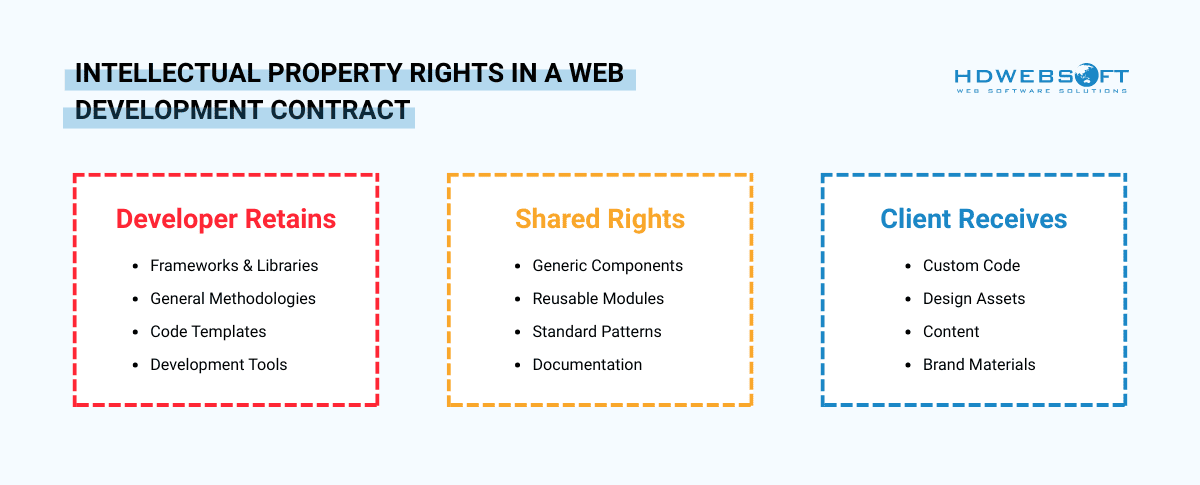
What Business Code Should Be Used for Contract Web Developers?
Understanding NAICS Codes for Web Development Contract
When formalizing a web development contract, proper business classification becomes essential for tax reporting and regulatory compliance. The North American Industry Classification System (NAICS) provides standardized codes that categorize economic activities.
For web development services, the primary code is 541511 (Custom Computer Programming Services). It covers businesses engaged in writing, modifying, and supporting custom software.
Why Classification Matters for Your Contract
Business classification codes impact multiple aspects of the contractual relationship. Tax authorities use these codes to verify proper income reporting, while jurisdictions require specific business licenses based on NAICS codes. Insurance companies use these codes to determine coverage types and premium rates. In addition, government contracts and grants may restrict eligibility to specific codes.
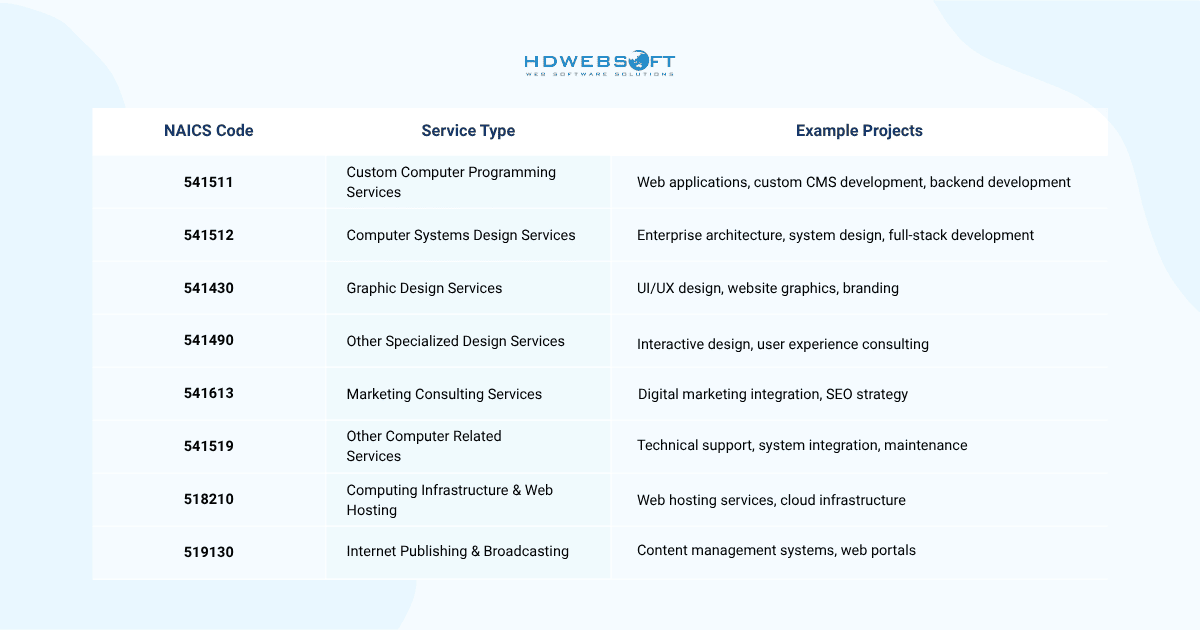
Including the appropriate NAICS code in your contract for web development agreement demonstrates professionalism and ensures proper classification.
Understanding Grey Areas in Web Development Contract
Common Ambiguities That Lead to Disputes
Despite best intentions, a web development contract may contain vague language that creates disputes. In recent research, 52% of all projects face scope creep, with ambiguous contract terms serving as primary enablers. These grey areas typically emerge in scope definitions, revision policies, compatibility requirements, and post-launch support obligations.
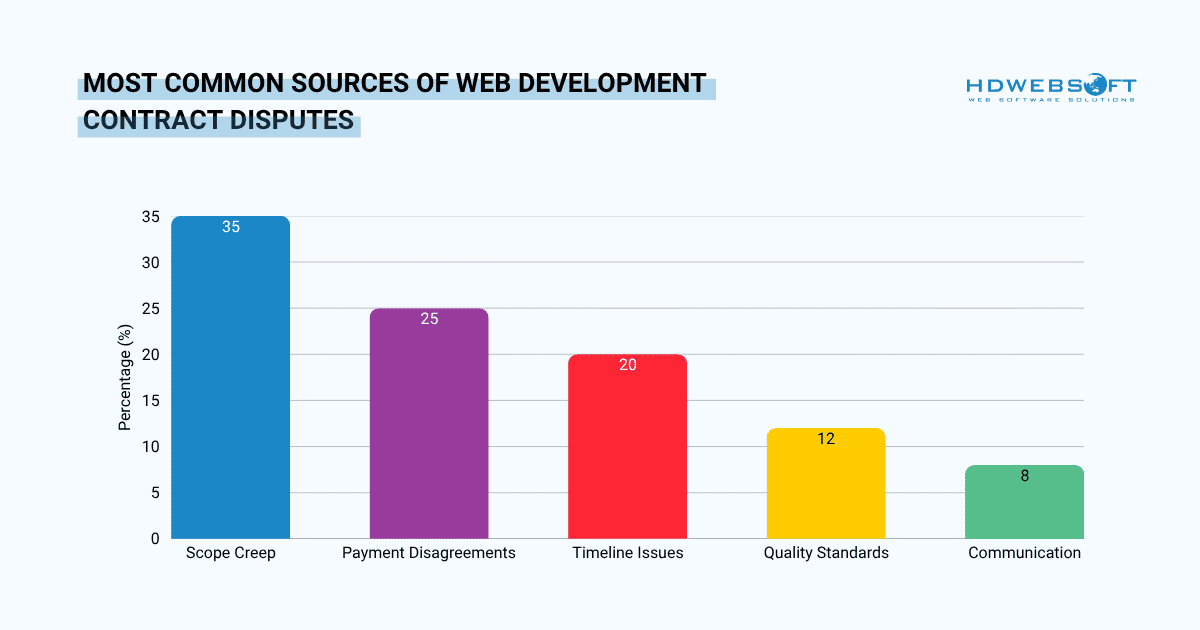
Scope Creep and Change Requests
Perhaps no issue causes more disputes than determining what constitutes “additional work” versus “clarification of original scope.” Preventing these disputes requires exhaustive initial specifications and formal change order procedures.
The contract for web development agreement should stipulate that any work not explicitly documented requires a written change order. It should detail the new feature, additional cost, timeline impact, and mutual approval before work commences.
The “Reasonable Revisions” Clause Problem
Many contracts include phrases like “reasonable number of revisions,” language that virtually guarantees conflict. Instead, contracts should specify exact revision allowances: “Client receives three rounds of design revisions. Additional revision rounds available at $500 per round.”
Furthermore, time-based restrictions in web development contract help: “All revision requests must be submitted within 5 business days of deliverable presentation.”
Browser and Device Compatibility Standards
Stating that a website will be “compatible with all major browsers” sounds reasonable, but proves meaningless in practice. The contract for web development agreement should explicitly list compatibility requirements with specific browser versions, mobile devices, and screen resolutions.
Technical Performance and Quality Standards
Beyond functionality, performance expectations frequently spark disputes when left undefined. Professional contracts establish measurable benchmarks. They are:
- Page load times under 3 seconds
- Minimum performance scores on Google PageSpeed Insights
- Uptime guarantees
- Security standards, including SSL certificates and HTTPS enforcement.
Post-Launch Support and Maintenance
Confusion about post-launch obligations causes friction when bugs emerge. Distinguishing between warranty coverage and ongoing maintenance prevents misunderstandings:
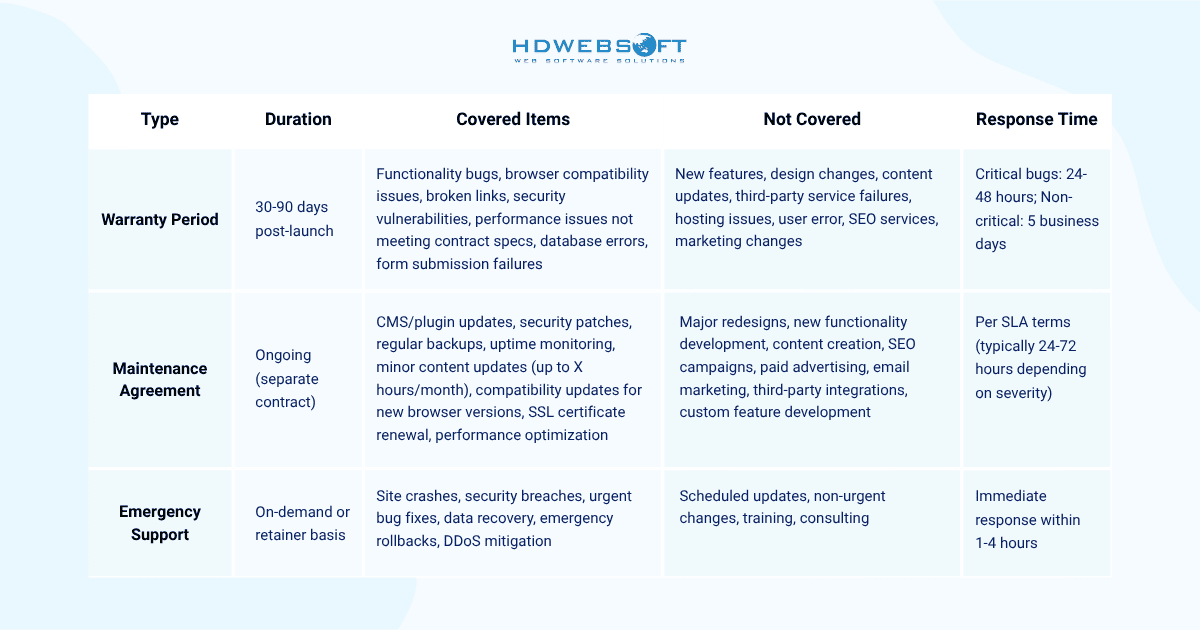
Minimizing Ambiguity Through Precise Language
Eliminating grey areas requires intentional specificity throughout the web development contract. Replace subjective descriptors with objective standards and examples.
Moreover, reference established guidelines like W3C accessibility standards rather than inventing arbitrary criteria. Visual documentation, such as wireframes, mockups, and style guides, proves invaluable as contract appendices.
Where to Find Contract Web Developer Services
Reputable Platforms and Marketplaces
Finding developers who provide comprehensive contracts requires navigating various sourcing channels. Online talent marketplaces like Upwork, Toptal, and Fiverr Pro offer extensive developer networks with built-in contract templates, escrow payment systems, rating systems, and dispute resolution mechanisms. However, marketplace contracts often provide minimal customization and may not address industry-specific needs.
Established Development Agencies and Firms
Partnering with established agencies generally provides more sophisticated contractual protection. Reputable firms maintain legal teams that craft comprehensive contracts, carry professional liability insurance, offer established processes, and provide team redundancy.
Red Flags When Evaluating Contractors
There are certain warning signs that should prompt serious reconsideration when entering a web development contract
Red Flags 🚩
- Refuses written contract
- Vague timeline estimates
- No IP clauses
- Requires 100% upfront
- No portfolio or references
Green Flags ✅
- Provides detailed contract template proactively
- Specific milestones with dependencies
- Clear ownership transfer provisions
- Milestone-based payments (20-30% deposit)
- Comprehensive portfolio with client references
Before signing any contract for web development agreement, conduct thorough due diligence: contact references, verify business registration, request proof of insurance, review portfolio samples, and consider starting with a small pilot project.
Key Clauses to Negotiate in Your Web Development Contract
Negotiable Terms That Benefit Both Parties
While certain contract elements remain non-negotiable, many terms offer flexibility. Payment schedule flexibility represents one of the most commonly negotiated terms. While developers typically prefer larger deposits (30-40%), clients may negotiate smaller deposits (20-25%). Rush projects might command premium rates, while larger projects might qualify for volume discounts.
Revision allowances similarly offer negotiation room. Standard contracts include 2-3 revision rounds, but clients willing to pay premium rates might negotiate more. Intellectual property terms occasionally allow shared arrangements where developers retain rights to reuse generic components. Meanwhile, clients gain exclusive rights to custom features.
Non-Negotiable Essentials for Protection
Certain elements in the web development contract should remain firm regardless of negotiation pressures. Quality standards and acceptance criteria must be explicit and measurable. Regulatory compliance requirements prove absolutely critical. For instance, contracts must mandate compliance with GDPR, CCPA, ADA/WCAG accessibility standards, and PCI-DSS where applicable.
Security requirements similarly demand unwavering standards: SSL certificate implementation, secure password storage, protection against common vulnerabilities, and regular security updates. Plus, ownership clarity must be absolute, and termination provisions should specify conditions, notice requirements, payment obligations, and deliverable handover procedures.
Balancing Interests for Long-Term Success
The most successful contracts balance protection with partnership, establishing clear boundaries while maintaining flexibility for adjustments. Rather than approaching contracts adversarially, viewing them as relationship frameworks produces better outcomes. Fair payment terms, realistic timelines, clear communication protocols, and transparent change management create foundations for successful projects and ongoing relationships.
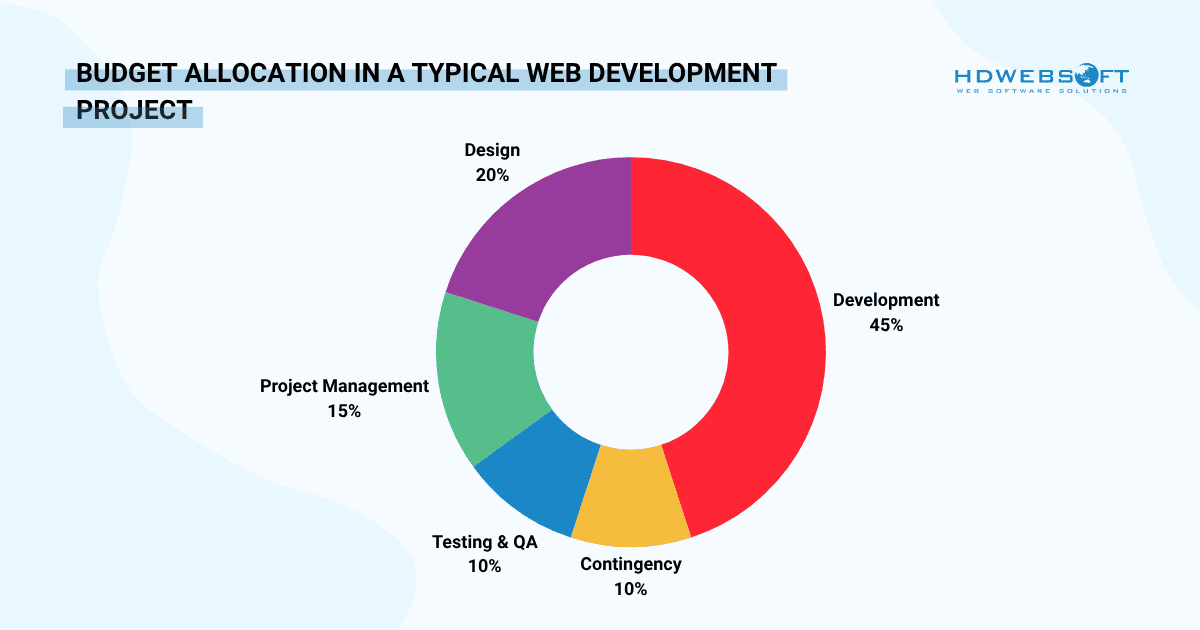
budget allocation in a typical web development contract
Best Practices for Contract Management
Documentation and Communication Protocols
Creating a comprehensive web development contract represents just the beginning; effective execution requires disciplined documentation throughout the project. Establish structured communication protocols including regular progress meetings, designated contact persons, preferred communication channels, and response time expectations. Documentation practices should include change order tracking, meeting notes capturing decisions, approval documentation for milestones, and comprehensive testing reports.
Handling Disputes and Changes
Even with meticulous contracts, conflicts occasionally emerge. Effective agreements establish escalation procedures: direct communication between project leads, management involvement if needed, formal mediation with neutral parties, and arbitration or litigation as final options. Most contracts favor arbitration over litigation due to lower costs and faster resolution.
Conclusion
Throughout this exploration of a contract for web development agreement, one truth emerges.
Investing time in creating thorough agreements protects your investment and prevents costly disputes. Every contract element serves critical protective functions that benefit both parties.
Rather than viewing contracts as burdensome formalities, successful organizations recognize them as essential project management tools. Whether you work with top-rated web development firms or independent contractors, a solid contract for web development agreement creates the foundation for outstanding results.
If you’re ready to move forward with your web development project, consider partnering with HDWEBSOFT. As one of the leading web development firms, we specialize in delivering custom website development services backed by transparent, comprehensive contracts. Our team maintains professional project management and open communication throughout your development journey. We make sure that your project succeeds on time, within budget, and with complete clarity on all deliverables and timelines.










